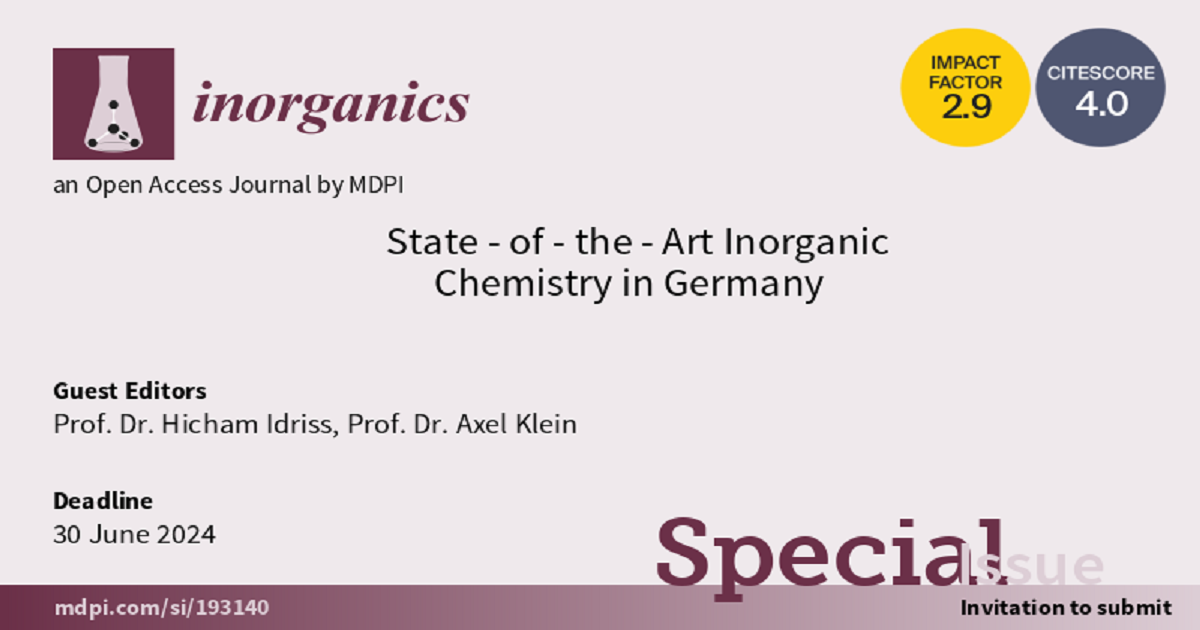State-of-the-Art Inorganic Chemistry in Germany
A special issue of Inorganics (ISSN 2304-6740).
Deadline for manuscript submissions: 31 December 2024 | Viewed by 259

Special Issue Editors
Interests: catalysis; hydrogen production/water splitting; electron transfer; surface reactions; reducible oxides
Special Issues, Collections and Topics in MDPI journals
Interests: transition metal complexes (including organometallic); platinum, palladium, nickel; synthesis; electrochemistry; photophysics; spectroscopy; modelling of catalytic processes
Special Issues, Collections and Topics in MDPI journals
Special Issue Information
Dear Colleagues,
This regional Special Issue focuses on the frontiers of inorganic chemistry in Germany. Colleagues are invited to submit original articles, communications, and critical reviews. We welcome submissions that are within the scope of inorganic chemistry research.
Topics include but are not limited to the following research areas:
- Coordination chemistry;
- Organometallic chemistry;
- Bioinorganic chemistry;
- Solid-state chemistry;
- Inorganic materials;
- MOFs (metal–organic frameworks);
- Energy;
- Catalysis (including photo- and electro-catalysis).
Prof. Dr. Hicham Idriss
Prof. Dr. Axel Klein
Guest Editors
Manuscript Submission Information
Manuscripts should be submitted online at www.mdpi.com by registering and logging in to this website. Once you are registered, click here to go to the submission form. Manuscripts can be submitted until the deadline. All submissions that pass pre-check are peer-reviewed. Accepted papers will be published continuously in the journal (as soon as accepted) and will be listed together on the special issue website. Research articles, review articles as well as short communications are invited. For planned papers, a title and short abstract (about 100 words) can be sent to the Editorial Office for announcement on this website.
Submitted manuscripts should not have been published previously, nor be under consideration for publication elsewhere (except conference proceedings papers). All manuscripts are thoroughly refereed through a single-blind peer-review process. A guide for authors and other relevant information for submission of manuscripts is available on the Instructions for Authors page. Inorganics is an international peer-reviewed open access monthly journal published by MDPI.
Please visit the Instructions for Authors page before submitting a manuscript. The Article Processing Charge (APC) for publication in this open access journal is 2700 CHF (Swiss Francs). Submitted papers should be well formatted and use good English. Authors may use MDPI's English editing service prior to publication or during author revisions.
Keywords
- synthesis
- structure
- reactivity
- activity
- chemical properties
- physical properties
- applications
- inorganic compounds
- inorganic complexes
- inorganic materials
Planned Papers
The below list represents only planned manuscripts. Some of these manuscripts have not been received by the Editorial Office yet. Papers submitted to MDPI journals are subject to peer-review.
Title: Baden Blue: A Formate Analogue of Prussian Blue
Authors: Martin Viertelhaus, Jonas Braun, Sharali Malik, Christopher E. Anson, Annie K. Powell
Affiliation: Karlsruhe Institute of Technology (KIT)
Abstract: We report the solvothermal synthesis and crystal structure of [MgII(H2O)6][FeIII2{FeIIxMgII1-x}2(O2CH)12]·3HCO2H. The dark blue compound crystallises with a cubic lattice in which trivalent iron ions alternate with divalent iron or magnesium ions in a similar fashion to Prussian Blue. Rather than having cyano bridges the metal ions are connected by formate bridges. This creates an intervalent system as shown by the magnetic and spectroscopic data.
Title: Synthesis of tris(trifluoromethyl)nickelates(II) – Coping with the C2F5 problem
Authors: S. A. Schäfer, R. Jordan, F. Herwede, A. Klein*
Affiliation: Department für Chemie, Institut für Anorganische Chemie, Universität zu Köln, Greinstraße 6, 50939 Köln, Germany
Title: 2,1,3-Benzoselenadiazole as mono- and bidentate N-donor for heteroleptic Cu(I) complexes: synthesis, characterization and photophysical properties
Authors: Valentina Ferraro; Fabian Hoffman; Olaf Fuhr; Burkhard Luy; Stefan Bräse
Affiliation: Institute for Biological Interfaces 4 (IBG-4), Karlsruhe Institute of Technology (KIT), Kaiserstrasse 12, 76131 Karlsruhe, Germany
Abstract: Mono- and binuclear Cu(I) complexes having 2,1,3-benzoselenadiazole (BSeD) as N-donor ligand were synthesized and isolated as perchlorate salts. Triphenylphosphine and bis[(2-diphenylphosphino)phenyl] ether (DPEphos) were employed as P-donors. The derivatives were obtained through displacement reaction starting from CuCl in the presence of AgClO4. 77Se NMR was measured for the free ligand and the related Cu(I) derivatives supporting the proposed formulae. The structure of the Cu(I) complexes was confirmed by single-crystal X-ray diffraction. The three Cu(I) complexes were characterized by intense absorption under 400 nm and, after being excited with blue irradiation, the derivatives having triphenylphosphine in the coordination sphere exhibited weak red emissions centered at 700 nm with lifetimes in the microsecond range. The geometry of the Cu(I) complexes was optimized through DFT calculations, and the photoluminescent properties were supported by TDDFT computations.
Title: Direct Synthesis of C-substituted [RC(O)CH2-CB11H11]- Carborate Anions
Authors: Vanessa C. Barra; Eduard Bernhardt; Sarah Fellinger; Carsten Jenne; Shiomi Sophia Langenbach
Affiliation: Anorganische Chemie, Fakultät für Mathematik und Naturwissenschaften, Bergische Universität Wuppertal, Gaußstr. 20, 42119, Germany
Abstract: A new synthetic method for the synthesis of C-substituted [RC(O)CH2-CB11H11]- carborate anions has been developed. The reaction of [closo-B11H11]2- with terminal alkynes in the presence of a copper catalyst leads to insertion into the boron cluster and C-substituted [RC(O)CH2-CB11H11]- carborate anions are formed. These reactions are strongly depending on the reaction conditions, the solvents and the alkynes used. The alkynes HCCCO2Et, HCCCO2Me, and HCCCONH2 lead to the formation of [NH2C(O)CH2-CB11H11]- as the final product in aqueous ammoniacal solution. In contrast, the reaction using the alkyne HCCCOMe yields [MeC(O)CH2-CB11H11]-. The products have been fully characterized by multinuclear NMR and IR spectroscopy as well as mass spectrometry. The crystal structures of K[NH2C(O)CH2-CB11H11] and [NEt3CH2Cl][NH2C(O)CH2-CB11H11] have been determined.






